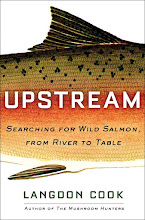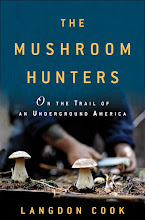It doesn't look like a great red huckleberry year, and first reports coming in from the early-ripening mountain huckleberries near Spokane are not encouraging either. Was it the strange spring weather? The lack of July rain? Maybe it's just a cyclical thing. In any event, the red hucks on Tiger were pretty small and not in abundance, but we made the best of it. Lace demonstrated her finely honed hiking skills by whipping out the backpacker's berry receptacle of choice—a Nalgene bottle—and dexterously filled it in no time.
Red huckleberries (Vaccinium parvifolium) are the first of our many huckleberry species to fruit in the summer, generally preceding their darker cousins by a few weeks. Though found sporadically in the interior as far east as Idaho, they're at their best in the lowland mixed forests of the North Pacific Coast, from Central California up through British Columbia. The west-slope Cascade foothills are good habitat, and the rain forests of the Olympics are loaded with them. The berries are bright fire-engine red and a little more tart than most mountain huckleberries. They look especially good in a fruit salad.
We also found trailing blackberries, the native blackberry of the Pacific Northwest.
After picking and grazing through a series of bushes up and down the trail we headed back toward the parking lot, running into a black bear along the way that was engaged in the same pursuit. The bear eyed us for a moment, then ambled on into the patch, unconcerned.
Lace and I agreed that a tart would be a good choice for the berries. As I've mentioned here before, my baking skills are somewhat suspect so I tend to look for easy recipes. Lo and behold a recipe from Martha Stuart Kids for a simple, unfussy tart dough that can be formed in a muffin tin—right in my wheelhouse! I halved the recipe, since two dozen tarts seemed like overkill, and then set about to make a sweet cheese filling to offset the tartness of the berries.
Tart Dough
1/2 cup flour
3 tbsp cold unsalted butter, cut up
2 tbsp confectioner sugar
2 tbsp cold water
Combine flour, sugar, and butter in a food processor and pulse until grainy. Add the water a tablespoon at a time to food processor while running. Pulse until dough forms. I used my hands at the end to finish combining what the Cuisinart missed. Roll into a cylinder, wrap in plastic, and refrigerate for 30 minutes minimum or up to a day.
Sweet Cheese
1 8-oz package cream cheese, cut into 8 pieces.
6 tbsp sugar
1 large egg yolk
1 1/2 tbsp flour
1/2 tsp vanilla extract
lemon zest of half a small lemon
Combine cream cheese and sugar in food processor. Whir until smooth. Add flour, egg, vanilla, and lemon zest and whir again until creamy.
Berry Topping
1 cup wild berries
2 tbsp sugar
2 tsp corn starch
Briefly cook berries with sugar and corn starch until juices are syrupy.
For the final tarts I took my dough out of the refrigerator and sliced it into a dozen disks. Each disk I flattened into a 3-inch diameter round on a lightly floured surface before pressing into a muffin tin and forming into a cup. Each little tart—tartlet, if I may be so bold—then got a dollop of sweet cheese filling before being topped with a spoonful of the cooked red huckleberries and a few fresh blackberries. I baked the tartlets for around 20 minutes at 400 degrees.
They were met with approval.


























